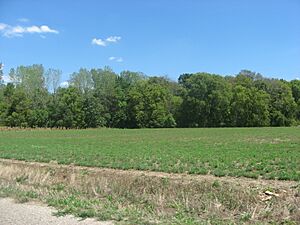Allison-Lamotte culture facts for kids
The Allison-Lamotte culture was a group of ancient people who lived in the Wabash River valley in the United States. They were an archaeological culture, meaning we know about them from the things they left behind. These people thrived from about 100 AD to 600 AD. Many of their old living sites are found near the modern city of Vincennes, Indiana. Scientists first described this culture in 1963. At first, they thought it had two main parts, called Allison and LaMotte. However, some experts now believe it was just one unified group.
How the Allison-Lamotte People Lived
The Allison-Lamotte people often built their homes along the Wabash River or its smaller streams. They usually chose land that was open grassland, called prairie, before settlers arrived. Many of their sites are also found near wet, marshy areas.
These people were Mound Builders. This means they built large earth mounds. But unlike some other groups of that time, their mounds were often not used for burying the dead. Many Allison-Lamotte villages were built in a circular shape. They had a central open area, like a town square, surrounded by round houses.
From studying the sizes of their houses, it seems that their society was quite equal. They probably did not have a strict class system where some people were much more powerful than others.
The Allison-Lamotte people were skilled hunters. They often hunted animals like deer, turkeys, and turtles. They also gathered shellfish. For plants, they mainly ate hickory nuts and grew their own squash.
Their pottery and stone tools were similar to those made by other groups during the Late Woodland period. Earlier generations of the culture made pottery with rough, cord-like patterns. Later generations seemed to prefer stamping their pottery to create rough edges. Their stone tools, like projectile points (arrowheads or spear points), looked a lot like those found at nearby sites of other cultures. In fact, the Allison-Lamotte culture was so similar to its neighbors that it was hard for scientists to tell them apart for many years!
Important Places and Connections
One of the most important sites for learning about this culture is the Stoner Site. It is located in southeastern Illinois. The Stoner Site was discovered in 1930. The Allison-Lamotte people lived there for a long time, and there is not much evidence of other groups living there.
Things found at Stoner and other sites suggest that these people really valued special flint knives. These knives were made from thin, layered pieces of stone.
Some experts believe that the Allison-Lamotte people eventually developed into the Vincennes Phase of the Mississippian culture. The Mississippian culture was another large group of people who lived in the area later on. The Vincennes phase would have been connected to people living at the famous Angel Mounds site in southwestern Indiana and the Kincaid Mounds State Historic Site in southern Illinois.


